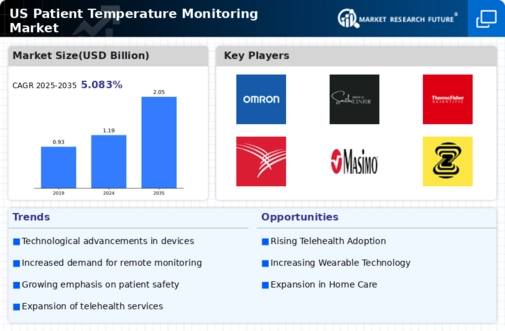Supportive Regulatory Environment
The patient temperature-monitoring market is positively impacted by a supportive regulatory environment that encourages innovation and the development of new monitoring technologies. Regulatory bodies in the US are increasingly streamlining the approval processes for medical devices, facilitating quicker access to advanced temperature monitoring solutions. This regulatory support is crucial for manufacturers looking to introduce innovative products that meet the evolving needs of healthcare providers and patients. As a result, the patient temperature-monitoring market is likely to benefit from an influx of new technologies and devices, enhancing the overall landscape of patient care and monitoring.
Technological Integration in Healthcare
The patient temperature-monitoring market is benefiting from the integration of advanced technologies such as artificial intelligence (AI) and the Internet of Things (IoT) into healthcare systems. These technologies enable real-time data collection and analysis, enhancing the accuracy and efficiency of temperature monitoring. For instance, AI algorithms can predict potential health issues based on temperature trends, allowing for proactive care. The market for smart temperature monitoring devices is projected to reach $1 billion by 2027, reflecting the increasing adoption of these technologies. As healthcare providers seek to leverage technology to improve patient care, the patient temperature-monitoring market is likely to see substantial growth driven by these innovations.
Increased Prevalence of Chronic Diseases
The patient temperature-monitoring market is significantly influenced by the rising prevalence of chronic diseases such as diabetes, cardiovascular disorders, and respiratory illnesses. Data indicates that nearly 60% of adults in the US live with at least one chronic condition, necessitating regular monitoring of vital signs, including body temperature. This trend underscores the importance of temperature monitoring as a critical component of disease management. Healthcare providers are increasingly adopting temperature-monitoring devices to facilitate timely interventions and improve patient outcomes. As the population ages and the burden of chronic diseases escalates, the demand for effective temperature monitoring solutions is expected to grow, thereby driving the patient temperature-monitoring market forward.
Growing Awareness of Preventive Healthcare
The patient temperature-monitoring market is experiencing growth due to increasing awareness among consumers. As individuals become more proactive about their health, there is a rising demand for tools that facilitate self-monitoring of vital signs, including body temperature. This shift towards preventive measures is supported by educational campaigns and health initiatives aimed at promoting regular health checks. The market for personal health monitoring devices is expected to grow by approximately 20% annually, indicating a strong consumer interest in temperature monitoring solutions. Consequently, the patient temperature-monitoring market is poised to expand as more individuals seek to take control of their health through regular monitoring.
Rising Demand for Remote Patient Monitoring
The patient temperature-monitoring market is experiencing a notable increase in demand for remote monitoring solutions. This trend is driven by the growing need for continuous health monitoring, particularly among patients with chronic conditions. According to recent data, the remote patient monitoring segment is projected to grow at a CAGR of approximately 25% over the next five years. This surge is attributed to the convenience and efficiency of monitoring patients' vital signs from home, reducing the need for frequent hospital visits. As healthcare providers seek to enhance patient engagement and improve outcomes, the integration of temperature monitoring devices into remote care strategies is becoming essential. Consequently, The patient temperature-monitoring market is likely to expand as healthcare systems adapt to evolving needs.



















Leave a Comment